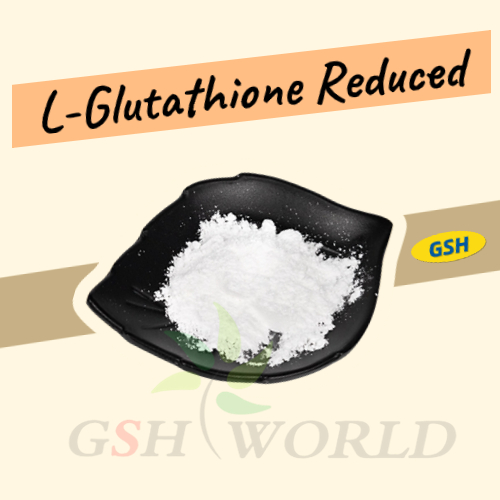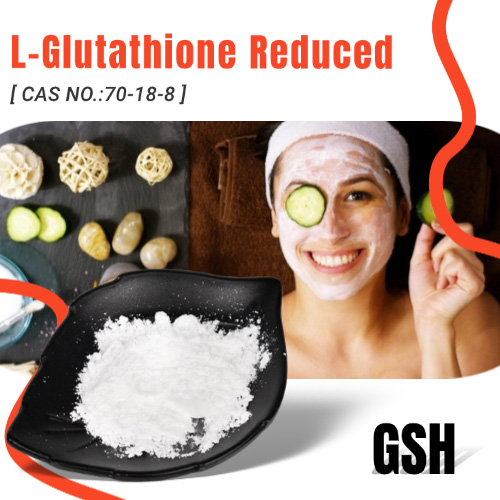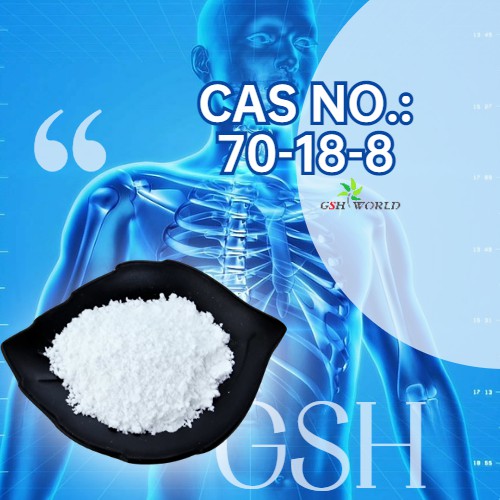Glutathione’s amazing bioactive tripeptide
Glutathione (GSH) is a bioactive tripeptide made from the dehydrated condensation of L-glutamic acid, glycine, and L-cysteine by peptide bonding.
First discovered by Hopkins in 1921, glutathione contains a large number of gamma-glutamyl and sulfhydryl bioactive groups.
Reduced form (GSH) and oxidized form (GSSG) are the two forms of glutathione that exist in cells and can be converted by glutathione reductase and NADPH.
What people refer to as glutathione (GSH) is usually reduced. GSH exists in yeast, animal liver, muscle and blood in nature.
The content of GSH in human red blood cells is higher, about 70mg/100 red blood cells. In addition, in many plants, such as vegetables, beans, grains, potatoes, mushrooms also contain a certain amount of glutathione, glutathione exists in high levels (~ 5mM) in animal cells, and plays the role of thiohydrogen buffer.
According to the study, the ratio of GSH to GSSG in most biological cells is greater than 500.

Glutathione is the body’s main antioxidant
When a small amount of hydrogen peroxide is produced in the cell, GSH, under the action of glutathione peroxidase, reduces H2O2 to water, which is itself oxidized to GSSG.
Glutathione is the main antioxidant in the body, which can resist the destruction of thiohydric group by oxidants and protect the proteins and enzymes containing thiohydric group in the cell membrane from oxidation.
GSSG receives hydrogen from NADPH and is reduced back to GSH under the action of glutathione reductase.
GSH also acts with organic peroxides, which are harmful byproducts of aerobic metabolism, and glutathione plays a key role in this detoxification.
Glutathione can also play a powerful anti-protective role in protecting cells from oxidative stress by trapping free radicals and neutralizing oxidizing substances. GSH works synergically with GSH peroxidase (GPx) in cells to reduce GSSG to GSH, thereby maintaining the function of the GSH system.
Glutathione also regenerates other antioxidants such as vitamin C and vitamin E, further boosting the antioxidant capacity of cells.
Glutathione also plays an important antioxidant role in the treatment of liver disease. Liver, as an important metabolic organ in the body, is vulnerable to oxidative stress, leading to the intensification of cell damage and inflammatory response. The antioxidant effect of glutathione can reduce the damage of oxidative stress on liver cells and protect the liver from free radicals and oxides.
Antioxidant effects also help to reduce lipid peroxidation and inhibit oxidative stress-related inflammatory responses and fibrotic processes.
Studies have shown that patients with liver disease are often accompanied by an increase in oxidative stress state, leading to cell damage and disease progression, and the antioxidant effect of GSH can help reduce oxidative stress, protect liver cells from further damage, and promote liver repair and regeneration.
Glutathione detoxifies the liver
The liver is the main detoxification organ in the body, responsible for metabolizing and removing harmful substances from the body, and glutathione plays an important role in the detoxification process by binding with harmful substances to form stable non-toxic substances and promote their elimination from the body.
Some studies have found that the level of glutathione is closely related to the liver detoxification ability, and patients with liver disease are often accompanied by a decrease in glutathione level. Supplementing GSH can enhance the liver detoxification function and reduce the damage of harmful substances to liver cells.
Glutathione also protects liver cells from drugs, chemicals and toxins, reducing liver damage.

In alcoholic liver disease, GSH can inhibit the apoptotic effect of alcohol on liver cells and reduce the degree of fibrosis, thereby protecting liver cells from damage and slowing the progression of liver disease, and glutathione can reduce the progression of liver fibrosis in patients with alcoholic liver disease and improve the survival rate of patients.
The level of glutathione is low in patients with viral liver disease, and the deficiency of GSH may be closely related to the progression of liver inflammation and fibrosis. Glutathione has antioxidant and anti-inflammatory effects, can reduce the oxidative stress and inflammatory response caused by viral infection, and protect liver cells from damage.
Glutathione production know how much
The main methods for the preparation of reduced glutathione are solvent extraction, enzyme synthesis, chemical synthesis and biological fermentation.
Solvent extraction method mainly uses the characteristics of different solubility of glutathione to extract in two different solvents, which is the most classic method of production methods, because the extracted glutathione purity and efficiency is low, so the actual production application value of this method is not great.
Enzyme synthesis is a natural synthetase plus ATP and substrate L-glutamic acid, L-cysteine and glycine three different amino acids to finally produce glutathione. This method is simple to operate, but the raw materials are rare, so it is not suitable for large-scale industrial use.
The basic raw material produced by chemical synthesis method the same as the enzyme method, which also three amino acids, and its production process relatively mature, but the product a racemate, and the racemate needs to separated by optical, so the problems such as high cost and environmental pollution limit the widespread production and application of this method.
Biological fermentation the most commonly used method to produce glutathione using relatively inexpensive sugars and strains, using the metabolic cycle of microorganisms. This method has simple reaction process, low cost, high conversion and production efficiency, and is the main method of glutathione production.
Dose-effect relationship of glutathione
The current study confirms that if the dose of glutathione 300 mg/day, less than 120 mg of cysteine may released from 300 mg of glutathione, while about 120 mg of cysteine can also obtained from 10-20 grams of meat or 100 ml of milk.
Experiments have shown that glutathione has an anti-convulsive effect, and the injection of GSH with 10 ~ 300nmo1 or SSG with 10 ~ 100nmo1 can significantly reduce the frequency of tonic convulsions and prolong the incubation period, and glutathione also has a certain inhibitory effect on clonic convulsions.

The application of glutathione
Because of its unique physiological function, glutathione widely used in medicine and food fields.
Developed countries such as Japan and the United States have developed and utilized glutathione as an addition to health food in the middle of the last century.
In food, glutathione can combined with flavor substances (such as sodium glutamate) to enhance food flavor, improve food stability, and extend the shelf life of food.
Using the antioxidant properties of the sulfhydryl group of glutathione to prevent Browning, adding GSH to vegetables, melons and fruits to replace traditional preservatives, plays a certain role in protecting the original nutritional value and color.
In terms of medicine, glutathione can remove oxygen free radicals, enhance antioxidant activity and improve the body’s antioxidant capacity, which is a very important antioxidant.
As an adjuvant drug, glutathione has widely used in the treatment of many kinds of diseases. GSH can protect liver damage caused by excessive alcohol intake by binding to metabolites of ethanol.
Glutathione can also used in the treatment of acute pancreatic inflammation, acute myocardial infarction, diabetes, etc.
Glutathione enhances the antioxidant capacity of skin by inhibiting the formation of melanin, and has the effect of beautifying, whitening and skin care.



